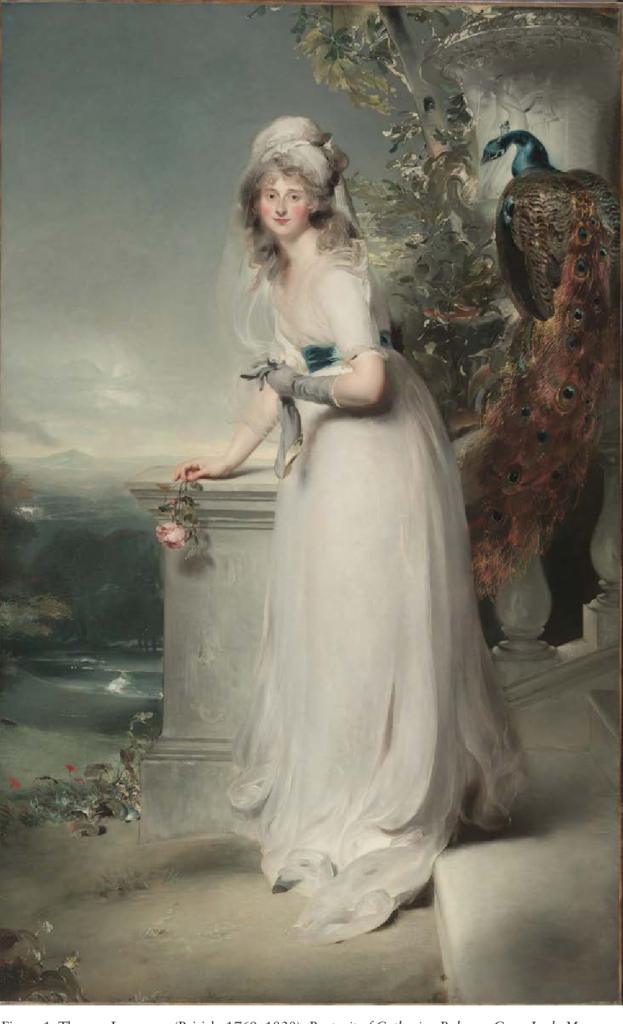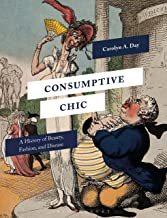Carolyn A. Day
London
Bloomsbury Visual Art
2017
189 pages
According to the art:
The author grapples with the question: “How is it possible that a disease characterized by coughing, emaciation, relentless diarrhea, fever, and the expectoration of phlegm and blood [i.e., tuberculosis] became not only a sign of beauty, but also a fashionable disease?”
Synopsis:
In this book, the author, Carolyn A. Day, attempts to answer this question: “How is it possible that a disease characterized by coughing, emaciation, relentless diarrhea, fever, and the expectoration of phlegm and blood became not only a sign of beauty, but also a fashionable disease?” (p. 2) She is referring to the period between 1780 and 1850 in Europe and Great Britain when cultural ideals of beauty and fashion converged with the physical appearance common to many people with tuberculosis (i.e., “consumption”).
The foundation of Day’s explanations are the social contexts shaping how people react to their illnesses, how they “reflect the intricate mix of circumstances that define life and social value, as well as its own significance in a given time.” (p. 3) With regards to tuberculosis and fashion during the period she considers,
There was a persistent and influential idea…that consumption, in its middle- and upper-class incarnations, was a disease that was not only identified by the existence of beauty in women, but one that also conferred beauty upon its sufferer. Thus, tuberculosis was rationalized as a positive affliction for women, one to be emulated in beauty ideals and fashions.
p. 5
In its most extreme application, the drive for the ultimate consumptive appearance took victims to their demise when the moment of death was the moment they reached their peak representation of the consumptive ideal. Day quotes a magazine writer of the time making the point: “in the last stage of a consumption a lady may exhibit the roses and lilies of youth and health, and be admired for her complexion—the day she is to be buried.” (p. 84) Alas, “the conviction that better things awaited the consumptive in the afterlife,” blunted the pain of losing these lives. (p. 42)
During the same period, Medicine was transitioning its understanding of disease as resulting from an imbalance among the humors to resulting from an “anatomico-pathological” origin. Under this new approach, and aided by the new diagnostic technique of percussion and the new technology of stethoscopes, physicians began approaching tuberculosis as a problem mostly involving lesions in the lung, and in the form of the “tubercle.” Towards the end of this period (1882), diagnosis of tuberculosis gained more precision from the discovery of a causative bacterium. The advancements in the conceptual and technological dimensions of Medicine generated a tension between the cultural drivers for fashion based on the ravaged physical appearances at the time—“consumptive chic”—and the predominant medical opinions inveighing against these fashions. Day refers to this tension as “a battle between professional and popular ideologies of disease—a conflict that played out both in beauty practices and dress.” (p. 81) She further notes that medical perspectives included considerations about whether the drive to embrace and emulate the consumptive look was a disease itself.
Day’s reading of history from this period has it that first there was a widespread “rage for illness,” and then “as the appearance of poor health became increasingly popular, one of the illnesses chosen as a model for emulation was consumption.” (p. 86) She attributes the aesthetic interest in tuberculosis to beliefs that it could beautify its victims when “the ideal feminine form in the nineteenth century tended to bear a striking similarity to those provided in the case of consumption.” (p. 87) Day is clear about this reading pertaining mostly to women of the middle- and upper-classes of Europe and Great Britain, who become victims because of hereditary predispositions common among those with “delicate sensibilities and social refinement.” (p. 133) Working class people contracted tuberculous also, but because of their environments and debaucheries, making it their own fault.
Day and coauthor Amelia Rauser, in an article published in Eighteenth-Century Studies (2016), point to the Thomas Lawrence painting, Portrait of Catherine Rebecca Grey, Lady Manners (1794) as a composite of the corresponding attributes of beauty and tuberculosis:
Lawrence’s controversial depiction of Lady Manners, particularly his unusual treatment of her hunched posture, pale skin, thinness, hectic flush, and curled fingers, evoked the pathetic appeal of the tubercular beauty in a society portrait of a healthy woman...a new gesture in the aestheticization of tuberculosis, using the diseased body as a visual metaphor for sensitive and artistic female beauty.
p. 457

Thomas Lawrence (British, 1769–1830)
The Cleveland Museum of Art, bequest of John D. Rockefeller, Jr
Day describes how physicians took aim at the clothing trends they thought contributed to contracting the disease. In particular, she notes their concern over garments that did not protect against cold weather, those that generated dust from their trains, and the corsets used to create the narrow chest and winged shoulder blades characteristic of the consumptive look (attributes also depicted in Lawrence’s portrait of Lady Manners). Their efforts would come to little avail. Day quotes a physician of the time saying, “It is vain to expect, that the warning voice of the physician will be listened to in preference to the dictates of fashion.” (pp. 123-124) She pinpoints the 1850s as when the connection between consumption and fashion began dissipating, and images representing the clinically and emotionally devastating effects of the disease emerged. Works by Alice Neel and Edvard Munch are illustrative.
Day includes fifty figures and thirty-four plates. She also tells stories of particular families and prominent individuals, which adds the emotional toll tuberculosis exacts from families and communities, and accentuates the irrational privilege fashion was given over health risks.
Though the book focuses on tuberculosis and fashion, Day acknowledges a time when consumption was associated with genius and artistic talents also.
For the Romantic, the mind of the languid individual suffering from consumption was enhanced, and mental energy grew as physical torpor increased. When this energy was applied to artistic creativity, health was sacrificed in favor of imagination and ingenuity.
p.46
She does not claim that the great writers, thinkers, and artists of the time had purposely contracted tuberculosis, but notes that because so many of them were in known consumptive states, a cultural sentiment took hold attributing their greatness to tuberculosis. This false association abated in the early twentieth century, and with it came the realization that tuberculosis did not enable greatness, but instead resulted in its loss. From then on, a good case of tuberculosis was never to be wished for.
Analysis:
On the face of it, the relevance of Day’s question is preposterous. How, indeed, could a fatal disease associated with overt wretchedness and suffering become a fashion ideal driving the desires of large swaths of middle- and upper-class women in Europe and Great Britain to embrace and emulate it? Moreover, how could this drive endure despite the loud, forceful, and persistent objections of medical professionals? Yet the question in 2022 is more than just relevant, it’s valid based on many well-known and modern-day behaviors people exhibit in the service of their vanity that put their health at risk. Consumptive chic was not an aberration.
The most direct examples are bulimia (self-induced vomiting) and anorexia nervosa (self-induced starvation) when consciously used by people attempting to attain a degree of thinness driven by contemporary cultural pressures. Others include the use of central nervous system stimulants such as nicotine, cocaine, amphetamines, and decongestants that suppress appetite and cause harm in a number of ways. Conversely, people will purposely avoid medications known to add weight, thereby losing the benefits of important treatments so as to maintain a desired appearance.
Not mentioned in the book, but worth noting is the attachment of fashion to behavior that threatens health arose again in the 1990s. Clothing designers began putting an emphasis on extreme thinness and their celebrity models adopted an emaciated and wrung out look. At the same time, heroin use increased as it became less expensive and available in forms that did not require injection. Heroin addicts looked like the models promoting skinny fashions, and so the fashion became known as “Heroin Chic.” While this fashion trend may not have motivated heroin use per se, it raised cultural alarms in fear of such a prospect to a degree that drew the attention of the U.S. president (Clinton), and consequently was short-lived. Nevertheless, the episode reminds us that even now people can pursue fashion trends at the expense of their health, or in Day’s formulation, embrace diseases that beautify as they destroy.
Also:
Portrait of Catherine Rebecca Grey, Lady Manners, and associated quote from:
Day C, Rauser AF. Thomas Lawrence’s Consumptive Chic: Reinterpreting Lady Manner’s Hectic Flush in 1794. Eighteenth-Century Studies. 2016;49:455-474.
Portrait of Catherine Rebecca Grey, Lady Manners, is available through open access at the Cleveland Museum of Art. Accessed January, 2023.
Further discussion on the cultural perspective about TB as conveyed by the Portrait of Catherine Rebecca Grey, Lady Manners, and as it contrasts with the cultural perspective conveyed by Alice Neel’s painting, T.B. Harlem is available in this episode of the podcast The Clinic & The Person.



